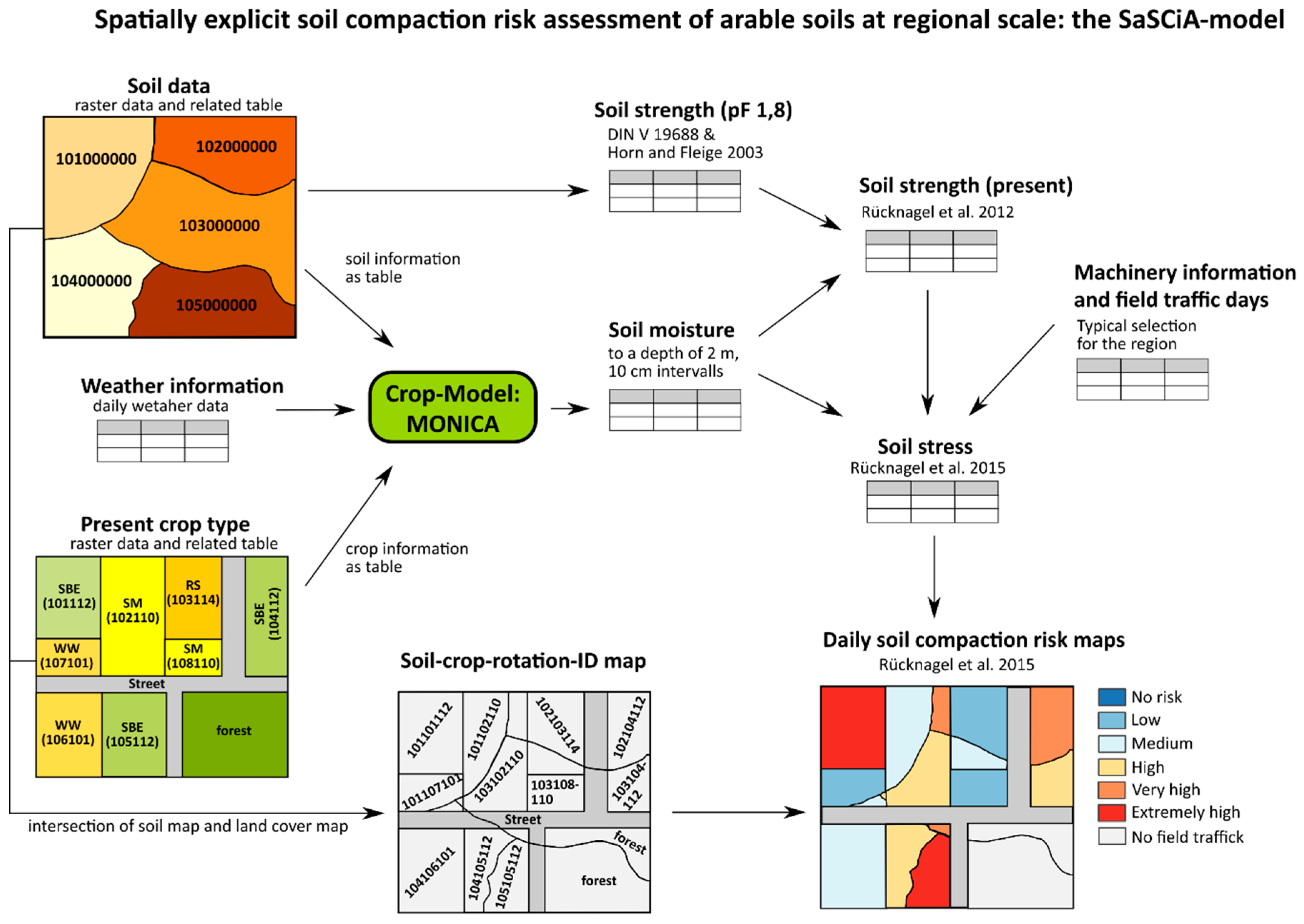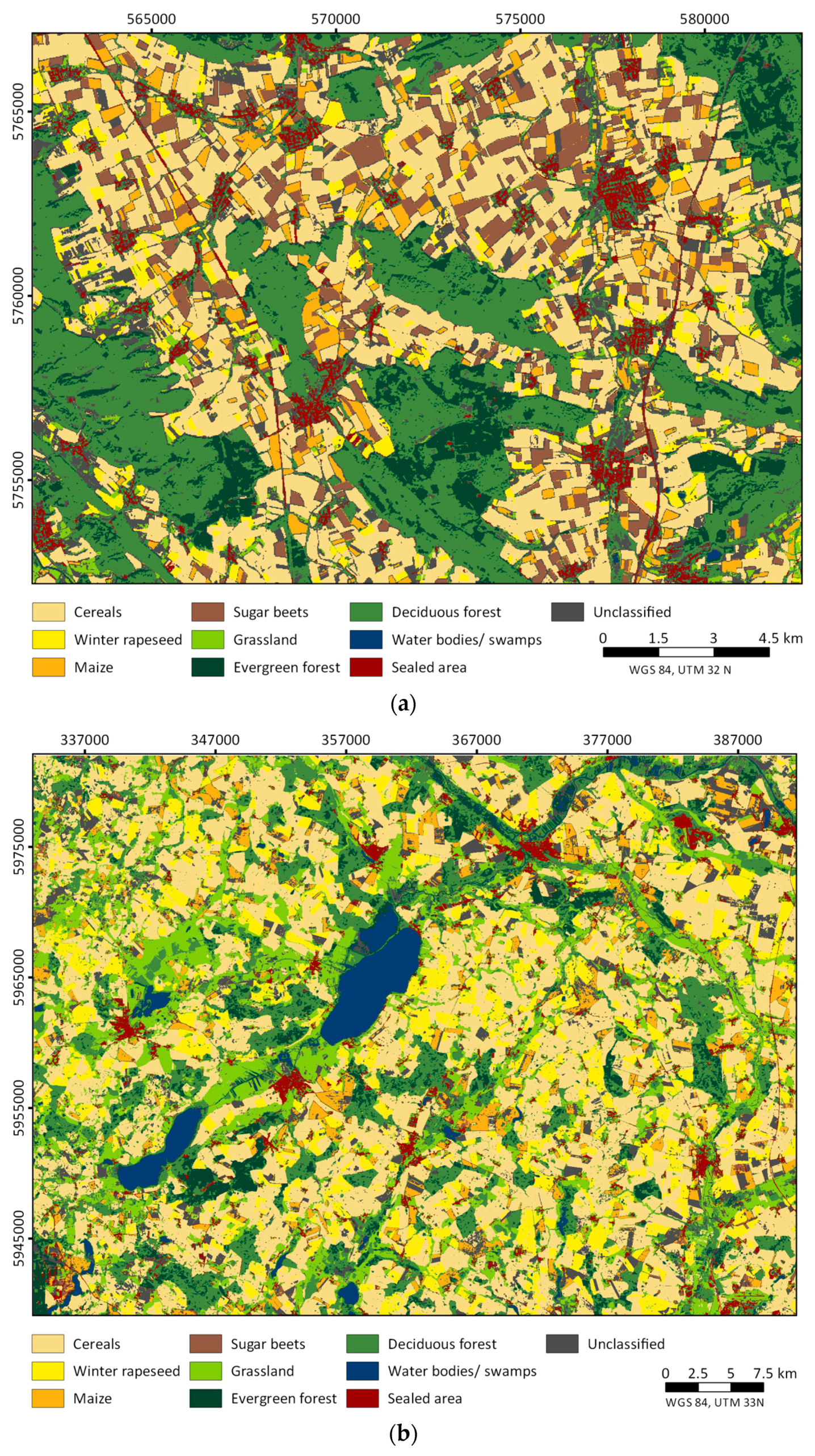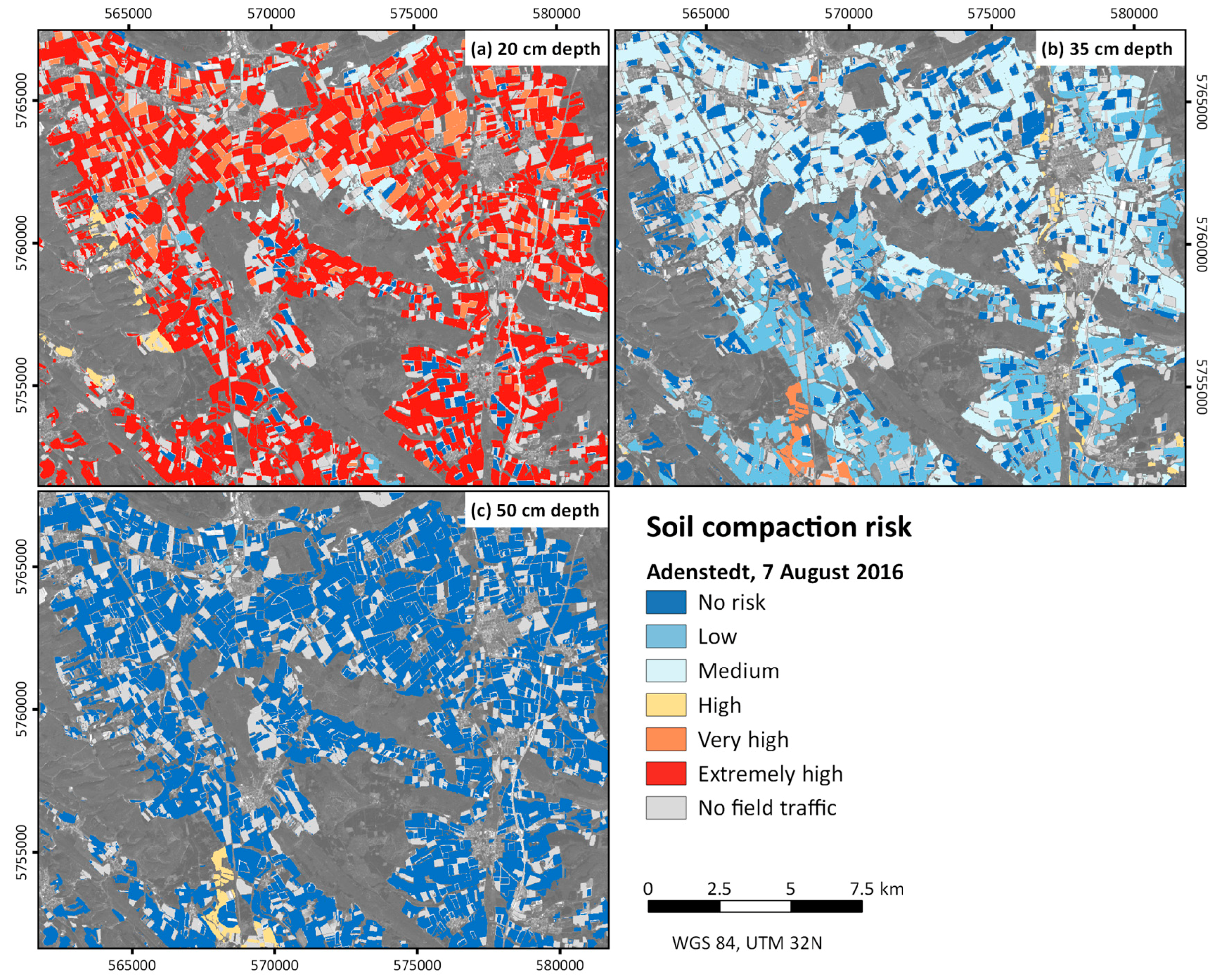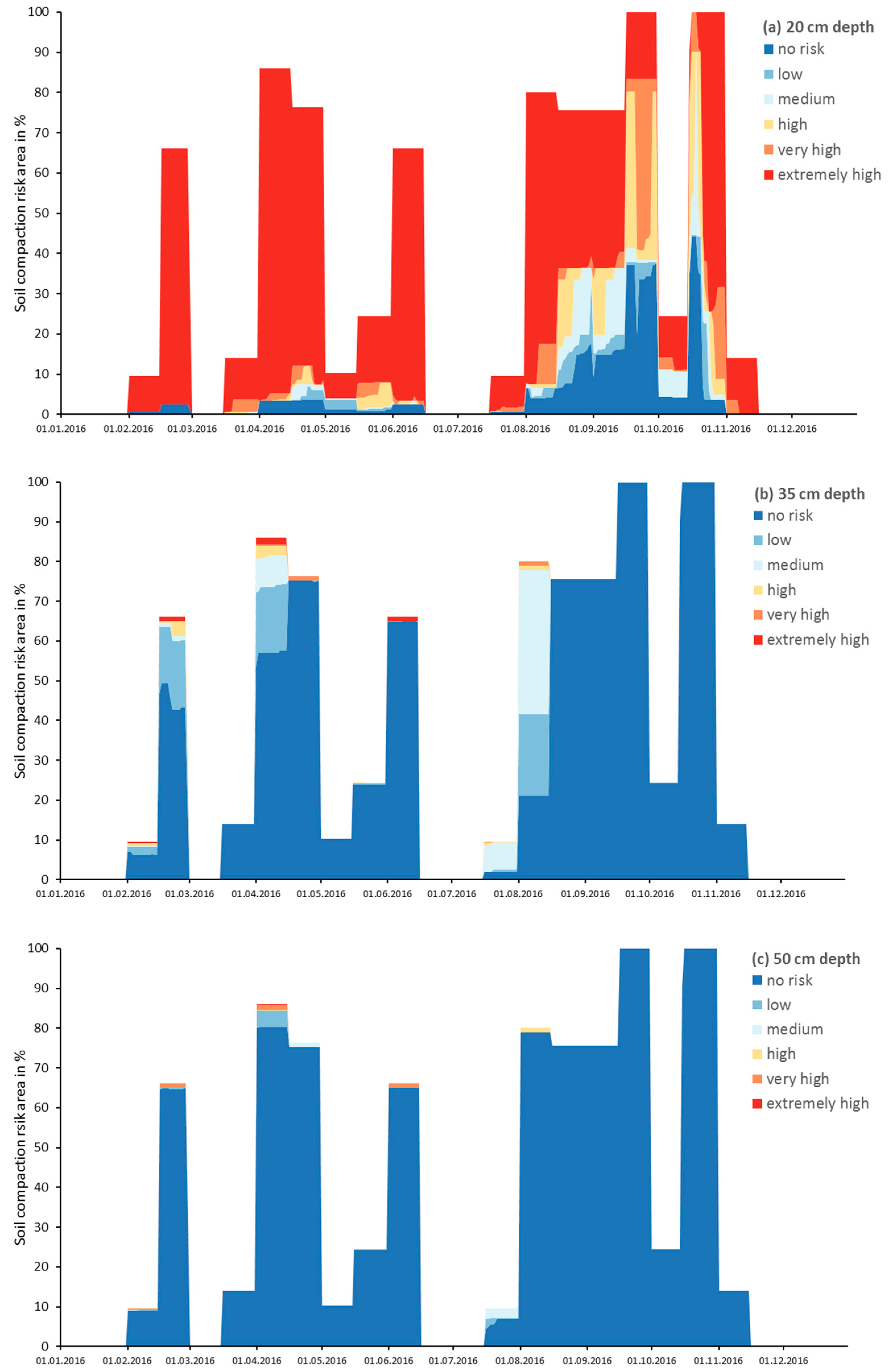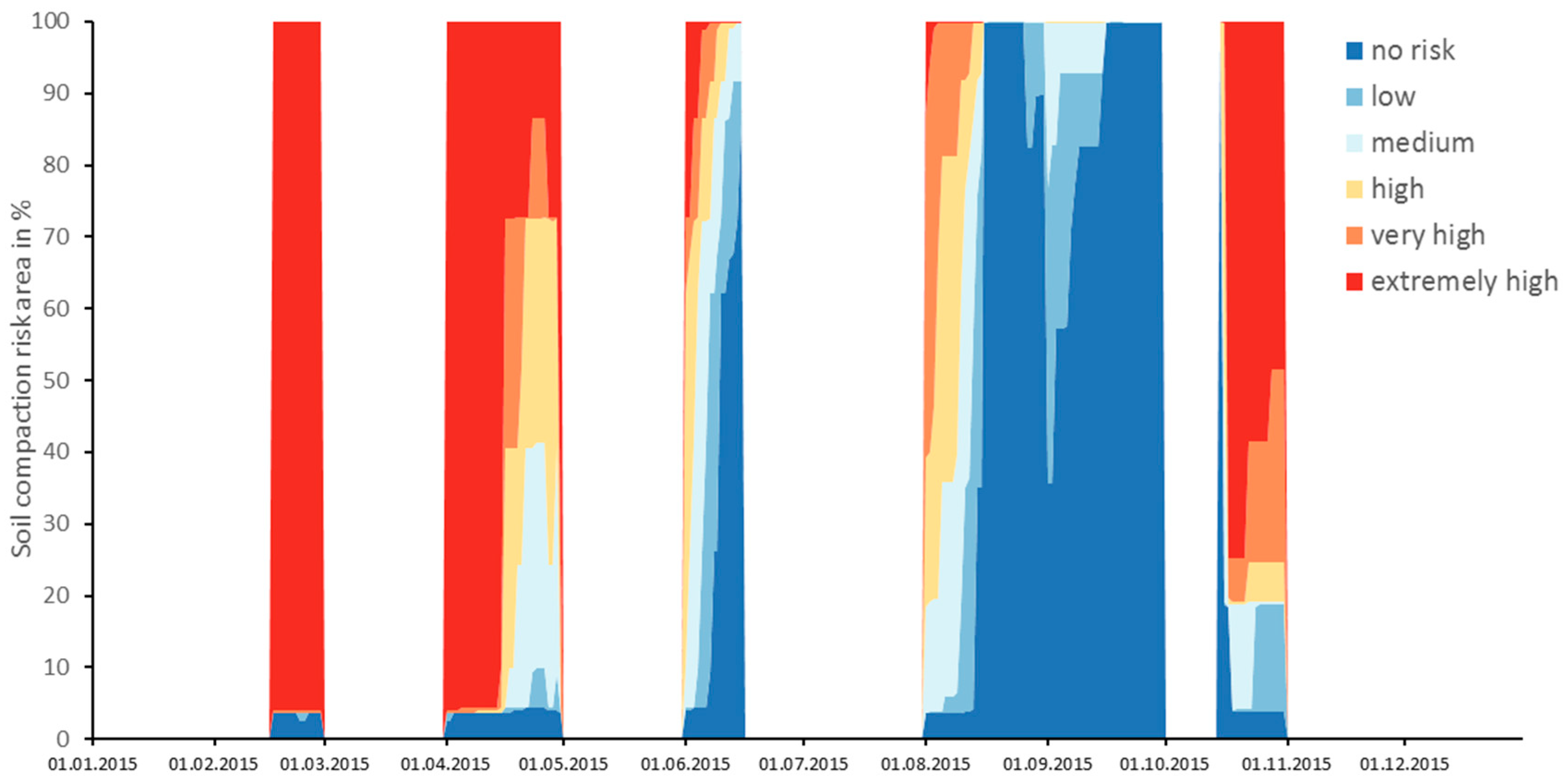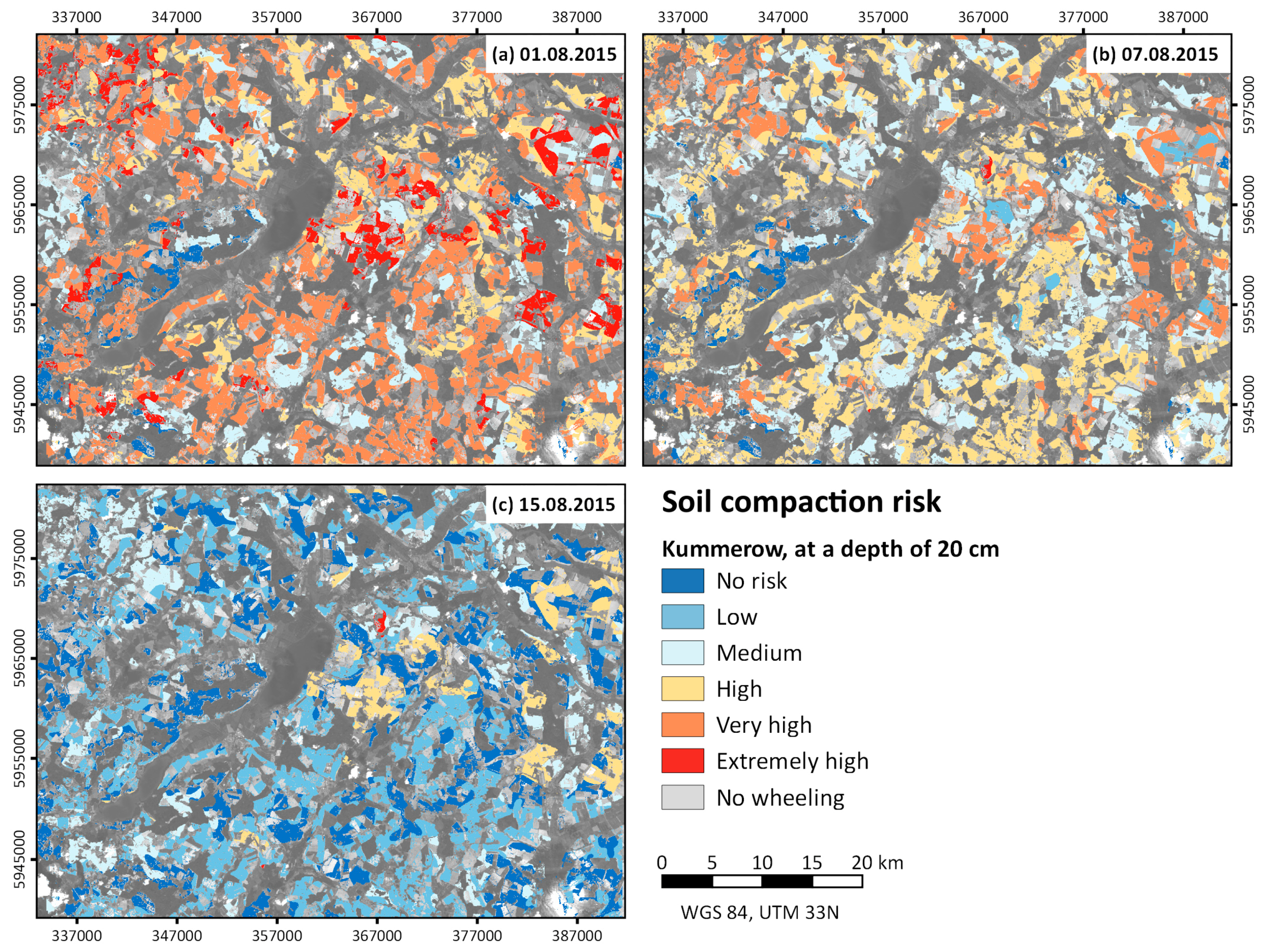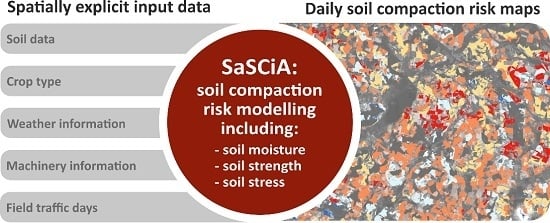4.2. Temporal Variation of Soil Compaction Risk
The spatial distribution of soil compaction risk for individual days enables the analysis of the temporal variation for an entire year. Temporal changes of soil compaction risk depend on weather conditions, related crop growth and varying wheel loads.
Figure 4 illustrates an example for different depths (20, 35 and 50 cm) at Adenstedt. The area percentage of the individual soil compaction risk classes (ordinate) is highlighted for each day in 2016 (abscissa).
The percentage area affected by field traffic varied between 0% and 100% for arable land throughout the year. No field traffic occurred during winter (January, second half of November and December), in the first half of March and from mid-June to mid-July leading to 0% affected area. During the second half of September and second half of October, field traffic affected the entire arable area, i.e., 100%. During the remaining months, the percentage varied between 9.8% and 85%.
Figure 4 depicts strong leaps of the percentage of soil compaction risk area between certain dates, e.g., 9.5% on 31 July 2016 and 80% on 1 August 2016. These sharp transitions marked the edges of field traffic periods defined in SaSCiA prior to the model run and depend on the particular crop type. This explains, why the area percentage of soil compaction risk at a given date remained the same for all depths (
Figure 4a–c), while the share of the soil compaction risk classes varied at the different depths.
For the topsoil (20 cm), the SaSCiA-model revealed the highest soil compaction risk with a high proportion of “high” and “extremely high” risk classes throughout the year. During spring, almost each field traffic activity resulted in an “extremely high” soil compaction risk. In November, each field traffic activity resulted in “high” and “very high” soil compaction risk. In spring and autumn, the high percentage of “high” risk area resulted from high soil moisture. In northern Germany, most precipitation occurs from November to March, while plant transpiration is very low. The wet soil therefore has a low soil strength and is unable to withstand the applied stresses, even of low wheel loads. In summer, the amount of precipitation is low, while plant transpiration rate is high. Soil strength increases with decreasing soil moisture, resulting in a reduced soil compaction risk. Accordingly, the percentage of soil compaction risk classes “low” and “no risk” increased at the beginning of August. Nevertheless,
Figure 4 shows that a high percentage of fields remained highly exposed to soil compaction in summer and early autumn. At this time, the harvest activities led to highest wheel loads (5000–10,000 kg), causing soil pressures that exceeded the soil strength even of dry soils.
Below the tillage depth (35 cm) and in the subsoil (50 cm), the soil compaction risk was low for the entire cropping season. At a depth of 35 cm, “no risk” areas predominated. From February to the end of June, SaSCiA revealed a “high” or “extremely high” soil compaction risk only for 3% of the arable land. “Low” to “medium” classes shared 23%. The majority of the trafficked area, however, showed “no risk”. During the first half of August, only 3% were classified as “high” and “very high”, 55% were classified as “low” to “medium”. From the second half of August until the end of the year, all field traffic activities resulted in “no risk” of soil compaction. At a depth of 50 cm, the soil compaction risk decreased continuously compared to the depths at 35 cm. The class “extremely high” never occurred; classes “high” and “very high” had a maximum of 2%. Soil compaction risk classes “low” and “medium” resulted in a maximum of 7%. The majority of field traffic activities were classified as “no risk”. The low soil compaction risk in autumn contradicts the expectation that maize and sugar beet harvest cause the highest soil compaction as reported by e.g., Nevens and Reheul [
72], Peth et al. [
13] and Destain et al. [
40]. In 2016, precipitation sum from July to September was 50% lower (93.2 mm) compared to long-term measurements (184.7 mm) [
50]. The low precipitation led to dry soils especially in the subsoil. The dry soil compensated most of the applied soil pressure in the topsoil, resulting in a less affected subsoil.
To demonstrate the influence of weather conditions, the soil compaction risk assessment for Adenstedt was repeated with the weather data from 2014. In 2014, precipitation sum was 240.6 mm [
50] from July to September representing a year with wet soil conditions during harvest. All other input data remained the same for this scenario.
Figure 5 shows the results of the wet scenario at a depth of 35 cm: a clear increase in soil compaction risk for harvest times (16 July to 15 August 2016 and 16 September to 15 October2016) emphasizes the effects of high wheel loads during wet soil conditions compared with dry soil conditions in
Figure 4. The results of the wet weather scenario are in agreement with the findings of the former mentioned studies [
13,
40,
72]: high wheel loads during maize and sugar beet harvest increase soil compaction risk.
4.4. Advances and Limitations of the SaSCiA-Model
The applicability of the SaSCiA-model has been demonstrated for two study areas in Germany with different spatial extent and varying land cover, pedological characteristics and weather conditions. The study highlights that the SaSCiA-model generates daily maps of soil compaction risk, which can support a sustainable field management and field traffic strategies to maintain various environmental functions of soils. The potential applications of the SaSCiA-model are manifold:
(i) Real-time soil compaction risk assessment
The SaSCiA-model enables a real-time soil compaction risk assessment, if sufficient data (especially weather and crop type data) is available. Currently available spatial soil compaction models show only the potential soil compaction risk, which is of limited importance for decision-making under real field conditions. The spatio-temporal high-resolution maps produced by SaSCiA show areas with varying (time and space) soil compaction risk. SaSCiA, therefore, can be potentially used as communication and visualization tool. Thus, the up-to-date soil compaction risk maps may support farmers, stakeholders and consultants in making decision for a more sustainable agriculture.
(ii) Retrospective soil compaction risk assessment
The SaSCiA-model is also applicable for retrospective soil compaction risk assessments, as demonstrated in the case studies. As long as crop type information is available (e.g., derived from field mappings or from remote sensing data), the SaSCiA-model can be used to obtain retrospective daily soil compaction risk maps for the last year, decade or even longer (the Landsat archive provides data back to the 1980s). Additional information of former crop types derived by farmers or public institutions may also contribute to generate typical crop rotations for study areas and, therefore, long-term analyses of soil compaction risk.
(iii) Hot-spot detection
The continuous application of the model for several years may identify areas with high soil compaction risk year by year. This hotspot identification may help to prevent further soil compaction by means of adapted field cultivation. Since soil compaction reduces the infiltration rate and increases runoff, detected hot-spot areas may be subject to further investigations, e.g., regarding risk assessment of soil water erosion. Accordingly, Alaoui et al. [
7] recently published a review in which they advise the use of remote sensing and new methods of soil compaction mapping for flood analysis and flood prevention. The SaSCiA-model may contribute to this recommendation.
(iv) Deriving days of trafficability
Apart from the assessment of soil compaction risk, the SaSCiA-model may be used to calculate the maximum wheel load day-by-day until no risk (or low or medium risk) occurs. Such analyses, for instance, may provide recommendations to farmers on the maximum payload during harvesting.
(v) Scenario calculations
The study shows that the SaSCiA-model can also be used for scenario calculation. Incorporating modified weather data further enables the analysis of climate change on soil compaction risk. This may help to develop strategies for future machinery setup, field traffic behavior or crop type selection. Effects of crop types on soil compaction risk may be investigated by changing present crop types, e.g., winter wheat instead of maize. This may be of particular interest in regions with changing cultivation practices as observed in Germany; here, the amount of area cultivated with maize extremely increased in the last decade [
73,
74]. Since maize is one of the crop types causing highest soil compaction risk due to harvest in autumn under wet soil conditions, applying SaSCiA (present crop type (maize) versus an assumed crop type (e.g., winter wheat)) demonstrates changing soil compaction risks under different crop type cultivation.
The forecasting ability of the SaSCiA-model, however, depends on the quality and availability of input data and the assumptions necessary for a regional analysis. In addition, some limitations of the SaSCiA-model must be taken into account:
(i) Crop type detection
The crop type is a key factor for soil compaction risk assessment. Without spatially explicit crop type information, SaSCiA is unable to calculate the soil moisture; related field traffic activities and wheel loads therefore cannot be assigned. To calculate real-time or near real-time soil compaction risk maps, present crop types are required. The availability of freely available crop type data, however, is limited, especially for the present year.
For the two study areas, Sentinel-2A and Landsat 8 satellite data accompanied by field mappings served as input for the crop type mappings. Nevertheless, satellite remote sensing data allow a retrospective assessment; it may also help to identify crop type for the present years. Separation of crop types using remote sensing further depends on their spectral variability, i.e., the spectral signatures must differ significantly at the acquisition day of the satellite. Furthermore, the spectral variability within a crop type has to be lower that the spectral variability between crop types.
During summer months, matured rapeseed may have a similar spectral behavior as cereals; during spring, rapeseed is in full bloom and differs significantly from cereals. After sowing in spring, both maize and sugar beets depict a similar spectral behavior as bare soil; consequently, they are spectrally easier to distinguish in late summer. After maize harvest, it is difficult to distinguish winter wheat as a subsequent crop and yellow mustard as catch crop, or weed growth. In general, images acquired directly after harvest or after sowing tend to impede an accurate crop type classification.
Moreover, the spectral/radiometric characteristics of the satellite sensors determine whether and which crop types can be identified [
75,
76]. Using satellite remote sensing for real-time crop monitoring therefore may be limited. Land use classifications using remote sensing data in spring or early summer, however, enable an assessment for the following harvest period. Using a series of land cover classifications for several consecutive years, typical crop rotations may also be derived (e.g., [
69]). Applying this crop rotation scheme allows a prediction of the following crop type, which then enables a soil compaction risk assessment for the subsequent year.
(ii) Assumptions for input-data
In SaSCiA, the spatial pattern of soil compaction risk results from spatially varying soil properties, crop types and derived soil moisture. Weather information, machinery information and field traffic days are assumed as constant values within the entire region.
For wheel load and tire inflation pressure, one value for each crop type and type of field traffic (e.g., sowing, spraying and harvest) can be specified. If more than one piece of machinery works in the field at the same time, e.g., during maize harvest, only one wheel load can be used for soil compaction risk assessment. In the case studies, the maximum wheel load, i.e., the worst case, was chosen. This may result in an overestimation of soil compaction risk, as wheel load changes dynamically; during sugar beet harvest, for instance, wheel load varies between the empty gross weight of 30 t and a fully loaded weight of 60 t. Some studies therefore focus on changes in wheel load at field scale (e.g., [
29,
77]). At regional scale, however, the wheel load affecting each raster cell remains unknown. Each part of a field may potentially be wheeled with the maximum load; hence, each raster cell may be affected with a maximum soil compaction risk. In SaSCiA, however, the wheel load and tire inflation pressure is user defined; it therefore depends on the user, which may also select the minimum or the average wheel load.
Due to a lack of information on the distribution of field traffic, the SaSCiA-model neglects rollover frequency. The number of wheel passages, however, affects soil functionality. Each wheel passage leads to a decrease of soil functions (e.g., [
78]). Highest field traffic intensity occurs in the headlands (turning areas of the field) and the tramlines [
77,
79]. The position of tramlines and headlands is highly variable, depending e.g., on field geometry and working width, which aggravates considering its effects at a regional scale. Since each raster cell could potentially be trafficked, any raster cell may be susceptible to soil compaction. Some studies therefore focus on the prediction of field traffic distribution based on field geometry and used machinery setup (e.g., [
80]). If these models are further developed, integration into the SaSCiA-model may overcome the disadvantage of missing rollover frequency.
The exact days of field traffic activity is another parameter, which is difficult to consider at a regional scale. The period for e.g., maize sowing lies within a range of weeks and the exact date of sowing depends on the farmer’s decision. The SaSCiA-model therefore integrates periods for each field traffic operation to consider varying field traffic days. The real field traffic activity will most likely occur within the specified period resulting in a reliable soil compaction risk assessment. If available, exact field traffic days can be used.
Another important point is the assumption of static characteristic of further soil properties, for instance dry bulk density and soil structure. The highly dynamic change of soil moisture is part of the SaSCiA-model. Further soil properties such as dry bulk density may also vary during the season as a result of drying-wetting, settling after tillage or other processes. The same applies for the effects of root growth after sowing. Roots may change the soil structure and increase the soil strength during the season. A recently published study reviewed possible impacts of vegetation on soil strength and trafficability [
81]. These changes are not considered automatically in the calculation of soil strength. However, effects of root/plant growth are considered in the MONICA-model. Thus, root/plant growth is considered in soil moisture calculation and, therefore, in the calculation of moisture dependent soil compaction risk. Apart from seasonal changes of soil properties, field traffic will affect soil properties. For instance, a traffic activity at the beginning of the year (e.g., fertilizer application) may increase the dry bulk density of the trafficked soil. The change in dry bulk density affects the subsequent calculation of soil strength and plant/root development and, therefore, the calculation of soil moisture. As the SaSCiA-model uses the soil properties given in the soil table and calculates the soil compaction risk based on these properties, changes of soil properties as dry bulk density are not considered automatically. A manual change of soil properties is (until now) the only way to consider seasonal, tillage or traffic induced changes in certain soil properties.
(iii) Model validation
Additional work is required to provide a validation of the SaSCiA-model. Model accuracy, of course, depends on the quality of the input data. Soil information, for instance, is an important input for the SaSCiA-model, but is often only available in a low resolution, as was the situation in the case studies. Thus, the soil information is spatially aggregated and the depiction of the soil heterogeneity therefore is limited. This is, however, rather a problem of data availability than of the model itself. The individual components/models of the SaSCiA-model are well established and proven: the ability to calculate the soil compaction risk for two soil moisture contents (pF 1.8 and 2.5) using the approach by Horn and Fleige 2013 [
15] at field, regional or higher scale was demonstrated by several studies [
23,
26,
27,
28,
29]. The MONICA-model was applied in studies to derive soil moisture and winter wheat yield at regional scale [
34,
41], which indicates its applicability in the SaSCiA-model. Götze et al. [
33] and Jacobs et al. [
82] successfully applied the approach from Rücknagel et al. [
32] to evaluate the soil compaction risk at individual farms.
It is therefore necessary to verify the predicted soil compaction risk resulting from the interaction of the single model components. This requires further fieldwork and soil sampling conducted before and after any field traffic activity, as described by Batey [
3]. The maps resulting from SaSCiA-modelling show the heterogeneous soil compaction risk at high spatial and temporal scales, thus enabling the detection of areas for appropriate soil sampling and model validation.

